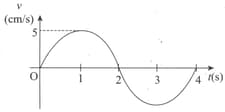Equation of Waves
Important Questions on Equation of Waves
A traveling wave in a stretched string is described by the equation . The maximum velocity of the particle is:
A simple harmonic wave-train is travelling in a gas in the positive direction of the -axis. Its amplitude is , velocity is and frequency is . Find out the displacement of the particle of the medium at a distance of from the origin in the direction of the wave at . Assume that the initial phase is zero.
A progressive wave has an amplitude and wavelength . If the maximum average velocity of particle, in half time period, is and the wave is moving in the positive -direction, then, which of the following may be the correct equation of the wave? (Here,is in )
A boat at anchor is rocked by waves whose successive crests are apart and velocity is . The boat bounces up once in every:
For a wave , for what value of is the maximum particle velocity equal to two times the wave velocity?
The linear density of a vibrating string is . A transverse wave is propagating on the string and is described by the equation , where and are measured in meter and in second. The tension in the string is,
A man generates a symmetrical pulse in a string by moving his hand up and down. At , the point in this hand moves downwards from mean position. The pulse travels with speed of on the string and his hand passes times in each second from the mean position. Then the point on the string at a distance will reach its upper extreme first time at time equal to?
The equation of a wave is given by . If the displacement is at , then the total phase at will be,
Equation of progressive wave is given by , where is in and is in . Then the distance through which the wave moves in is
In a string, the speed of the wave is and its frequency is . The value of the phase difference at a distance will be
A certain transverse sinusoidal wave of wavelength is moving in the positive direction. The transverse velocity of the particle at , as a function of time, is as shown. The amplitude of the motion is

Two particles of a medium, disturbed by the wave propagation, are at and . The respective displacements (in ) of the particles can be given by the equations:
and .
In the above question, the displacement of particle, at and , is
Two particles of a medium, disturbed by the wave propagation, are at and . The respective displacements (in ) of the particles can be given by the equations:
and .
The wave velocity is
Which of the following functions correctly represent the travelling wave equation for finite values of and ?

